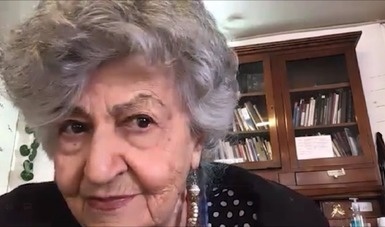-He…
Rosa turns me into a letter of the alphabet, l
of book, the l
of lemon, the l
of tears because for years, she herself covered her body with letters and made them dance the belly dance like a good oriental that attracts the Sun and the Moon and all the winds with the movement of its veils and the sudden appearance of lethal sinuosities.
In the 1960s, Alicia Trueba founded a literature workshop in a gym where it was easy to hear a squash ball clattering against the wall. That workshop had been taught by Rosario Castellanos and, when President Luis Echeverría named Rosario Castellanos our ambassador to Israel, one of her students called me by phone to see if she wanted to replace her.
I did not imagine that at that work table for 20 people a Rose of Jericho would be sitting, a Rose with short hair and an easy laugh, a questioning and troublesome Rose. I accepted with trepidation and at 11 in the morning I faced well-dressed women with crocodile bags. The workshop had a title: Creative writing
. I got scared and with an insecure voice I asked them at that very moment to write what they had felt that morning when they woke up. They have 15 minutes and they are going to read their texts aloud.
. They all read their writing with a very confident voice, just as Rosario had taught them.
Whose text do you think was the freshest and most original? Obviously Rosa Nissán, whose face I loved from the first moment at the rectangular table where 20 people sat to write. Among the women (there were only two men, one of them older) I saw a round, longing face with a bicycle cap and a low-cut blouse. We were all women of a certain age. She, younger, was shooting among the others. I was soon able to see that she brought the texts freer and more willing than the others.
Rosa Nissán knew how to free herself from the rules that have been imposed on us since we were children. She was not born free, on the contrary, she was born within a barbed wire fence of prejudices.
The unexpected lessons that Rosa Nissán gave us throughout years of coexistence are reflected in her writing that springs like a stream of water from the great fountain of her life: Girlfriend let me see you, Hisho que te nazca y A way comes to me sadness They are libertarian works as is the great chronicle of his trip to Israel.
Knowing her was for me a gift from the heavenly court and I began to treat her when the then president of Mexico, Luis Echeverría, named Rosario Castellanos ambassador of Mexico in Israel, because I inherited the workshop of the author of Poetry is not you, Balun Canan y Office of darkness.
At the long work table for future writers, the round face and short hair of Rosa Nissán appeared, and very soon other surprising voices emerged from that workshop, that of Silvia Molina, that of Guadalupe Loaeza, that of Alicia Trueba and above all of a great writer today fully fledged, Yuri Herrera.
One gray morning, Rosa arrived at my house in her gypsy wagon full of the most unexpected odds and ends and shouted to me from the street: Let’s go to the Desert of Lions
. And without further ado, once inside the walls of the convent, he ordered me: Now shout I’m young, I’m beautiful, I’m cool
. Are you sure, Rosita?
, Yes, Ele, you scream, don’t worry, only the trees will hear you
.
Since then, that cry has not stopped traveling through the branches of the trees and has reached the beaches of the Caribbean because there is no more beautiful memory than that of Rosa on the boardwalk in Havana, Cuba, in the early days of Fidel Castro.
My children Felipe and Paula went there, and it occurred to them to ask a girl if she was a communist. Seeing Rosa walk on the Havana boardwalk hit by the waves was a spectacle that stopped several walkers because, in addition to writing and laughing out loud, Rosa danced the navel dance. She moved it like someone moves a piece on a board: with wisdom, treachery and advantage, and when she finished she shouted: Check the King
, like someone giving an order. All Cubans became his subjects.
That cry was printed in his first book, Girlfriend let me see you and continued in Hisho que te nazca, The travels of my body and novels and stories. That cry has marked the novelistic work of a special woman who has liberated other women who live in her colony, the Countess. I assure you that without Rosa Nissán, the Countess would not be the Countess. To all those who venture through Parque México, to those in love, to the paper birds who are afraid to spread their wings and fly on their own, to those who spend the night watching the Moon, for a fauna free of dust and straw, Rosa Nissán has been a door to joy, spontaneity and talent.
Rosa Nissán Rovero was born in Mexico and her origin is Sephardic. When I met her, she spoke devotedly about her father and mentioned him all the time. She has continued to do so over the years. Another of her recurring themes turned out to be the exclusive Club Israelita and her huge pool. Belonging to that club was a sunny privilege for Rosita, who went swimming five times a week and also on Sundays, although she did not receive an award as an athlete, but as a writer when she was awarded the Ariel León Dultzin Prize, from the Association of Journalists. and Israeli Writers in Mexico, in 1994. Rosita is the author of the novel Girlfriend let me see you, which caused a sensation. A film version filmed by Guita Schyfter, the wife of the great writer Hugo Hiriart, cemented the fame of Rosita, who was born in Mexico City on June 15, 1939. She studied journalism at the Universidad Femenina de México and I met her years later. . With a lot of self-confidence and a beautiful cap on her head, she entered a literature class that Felipe Pardiñas had started, who in her time caused a sensation for being modern and very intelligent. Neither quick nor lazy, Rosa sat down almost immediately to write in the workshop of Alicia Trueba, founder of the workshop that now bears her name. Victorious, Rosa published her first novel in 1992: Girlfriend let me see you, which was lucky enough to be immediately recognized and made into a film, produced by Imcine in 1994 and directed by Guita Schyfter. Along with Hugo Hiriart, Rosa Nissán participated in the script that deals with the issue of Jewish communities in Mexico and questions the traditional role, customs and Sephardic traditions. Thanks to Rosita, I had the honor of attending the Bar Mitzsvah of Eli, her only male child, an emotional ceremony that I will never forget, since I saw Eli crowned with the Kipa for the first time and leaving the great temple in the Valle neighborhood.
In 1997, Rosita Nissán published a chronicle of her trip to Israel with the title The promised lands. Very well received, very applauded, it caused a sensation not only in the Israelita Sports Club but in other circles. So much so that it was translated into English and other languages.
In the late 90s, several literature circles, and especially writing workshops, were inspired by Rosita Nissán’s triumph. Some women followed her example and sat down to write her own life or that of her ancestors. Thanks to Rosita’s joy, her enthusiasm, her sense of humor, her critical ability, the naturalness of her person and her writing, followers of all ages emerged who jumped in to free themselves. of prejudices and insecurities.
In 1996, Rosa Nissán had already published her second novel, Hisho que te nazca in a beautiful edition of Plaza y Janés. This title turned out to be the literary consequence of Girlfriend let me see you and three years later it appeared The night is not just for sleepingwhich launched the Nueva Imagen publishing house, which contains stories that portray relationship problems that we all know and about which we laugh today when before they made us cry.
Starting in 2000, Rosa Nissán herself became a teacher and gave fictional autobiography workshops at the Casa del Lago, the Sor Juana Cloister and the Casa del Refugio. Rosa prepared her class with care and expertise acquired over the years. I remember having attended some Nissanian lectures at the Casa del Lago and being delighted with her capacity.
His literary career has gone from one success to another. Girlfriend let me see youpublished in 1992 by Planeta, has had several editions, as well as Hisho que te nazca (unavoidable consequence) and which Planeta also edited in 2006. One of my favorite novels is The promised landswhich Plaza & Janés launched in 1997, a story of a beautiful trip, in addition to The night is not just for sleepinglaunched in 1999 by the Patria publishing house.
The travels of my bodywhich Planeta published in 1999, established her as a very popular author with many young readers who admired her sincerity and sense of humor.
Thanks to A mode of sadness comes to me (what an excellent title!), which circulated starting in 2019, Rosa Nissán was sought after by future writers of both sexes. I especially remember Oscar Roemer, son of the orchestra director Ernesto Roemer and a man full of talent. Oscar was my clever classmate in fifth and sixth grade at Windsor School. Since Oshinica, belonging to the Sephardic community in Mexico, decided in the 1950s to write Girlfriend let me see youRosa Nissán grew the wings of a free soul, totally unprecedented, who taught us the art of living the customs of a Jewish community in Mexico.
Throughout her years of writing and her six trips to Europe, Rosa Nissán set out to rescue many followers with her critical and libertarian capacity, who were afraid of launching themselves into literature, painting or theater. Girlfriend let me see you, Hisho que te nazca y A mode of sadness comes to me They make up a life cycle that Susan Sontag in New York and Irène Némirovsky in France would have loved, Dara Horn, Jacqueline Shohet Kahanoff, Israeli essayist and journalist, intelligent women and critics of the limits that can be placed on the creative life of an artist.
#Rosa #Nissan #Elena #Poniatowska
– 2024-04-11 13:35:53


